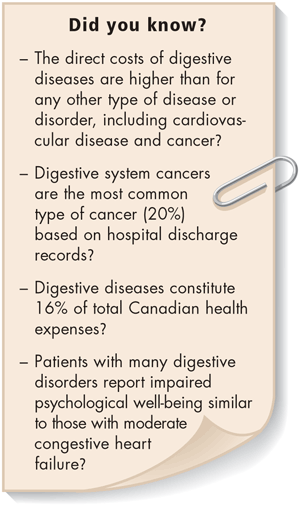Supporting Research and Public Education in Digestive Disorders
Gary A. Levy, MD, FRCP, President, Canadian Digestive Health Foundation; Director, Multi Organ Transplant Program, Toronto General Hospital, University of Toronto, Toronto, ON.
The Burden of Digestive Disorders in Canada
Many are aware of the devastating impact that diseases such as cancer and heart disease have on Canadians. However, few might realize that digestive diseases constitute an even greater health and economic burden, and seriously impair quality of life.
Despite the staggering statistics (see sidebar), funding for education and research from provincial and federal agencies lags far behind the prevalence and burden of disease. As an example, from 1988-1998, successful government gastroenterology grants decreased from 76 to 53. The total dollar value for digestive disease research also decreased from $6 million to $4.4 million over the same period.

Introducing the Canadian Digestive Health Foundation
In 1991, the Canadian Digestive Health Foundation (CDHF; then the Canadian Digestive Disease Foundation) was formed by a small group of Canadian gastroenterologists interested in enhancing the profile of gastroenterology in Canada and generating a stable source of funds for research and education. In 1994, the Foundation became a charitable organization. Between 1995 and 2000, one to two grants in gastrointestinal research were awarded annually, funding seven young investigators who have since become key members of the Canadian GI research community. However, it was only in the last few years that the organization began to grow towards its full potential.
In 2001, renewed support allowed the Foundation to establish a National Office. The Canadian Association of Gastroenterology (CAG), a professional society of physicians, other health care professionals and basic scientists, fully endorsed the Foundation as its fundraising foundation. Strong ties with the Canadian Institutes of Health Research (CIHR) offered new research funding opportunities. With this revitalization, the organization became the Canadian Digestive Health Foundation and redefined its mandate.
In 2001/2002, the Foundation made great strides in the arenas of research and public education. A detailed listing of all CDHF-sponsored research can be found on the CDHF website.
Public Education and the CDHF
Last year the CDHF launched its website (www.cdhf.ca) as the primary means of providing education for patients and the public regarding digestive diseases. Among other resources, the site contains a growing library of information on various gastrointestinal problems, prepared by key Canadian medical experts specializing in the area. While contacts from patients have confirmed the usefulness of this information, patients clearly desire a forum to interact with medical specialists regarding their particular situation. To meet this need, the CDHF is pleased to introduce a new program coming in January 2003 called Ask a Specialist.
This program allows you and your patients to ask a Canadian gastrointestinal specialist a question about a particular digestive disorder or health issue, via e-mail, and receive an answer within seven days. Please join us for the first installment in the series, Ask a Specialist About Dyspepsia, beginning January 1, 2003 at www.cdhf.ca.
